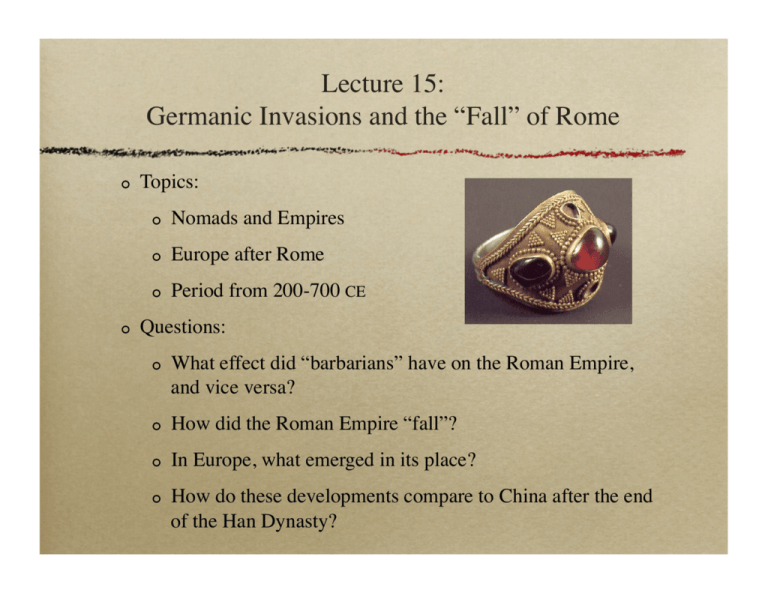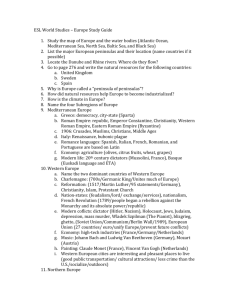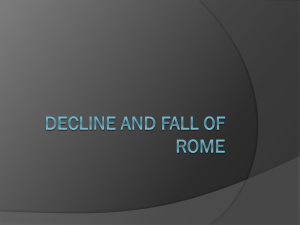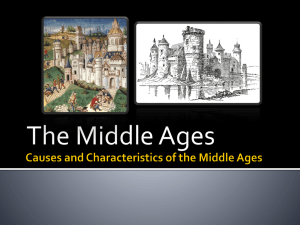6A Germanic Invasions.key
advertisement

Lecture 15: Germanic Invasions and the “Fall” of Rome Topics: Nomads and Empires Europe after Rome Period from 200-700 CE Questions: What effect did “barbarians” have on the Roman Empire, and vice versa? How did the Roman Empire “fall”? In Europe, what emerged in its place? How do these developments compare to China after the end of the Han Dynasty? Internal Problems of the Late Roman Empire economic decline crisis of authority external threats provincial elites East/West differences Solution: Division or Unity? Diocletian (284-305 CE): tetrarchy = 2 senior + 2 junior emperors Constantine (306-37 CE): unity new Eastern capital = Constantinople After 395 CE, 2 emperors: East and West Roman Europe Christianization progresses Germanic peoples threaten Rhine-Danube frontier Northern capitals: Trier, Milan, Ravenna Roman basilica in Trier Germanic Peoples Tacitus (55-117 CE) Germania How does Tacitus describe them? Correcting some misconceptions: Germanic tribes long in contact with Romans Roman frontier was not impermeable Agricultural: often migrated in search of land Germanic “tribes” not fixed ethnic units Not all “barbarians” were Germanic Some Germanic peoples settled within Roman Empire (as “federates”) before Rome “falls” A pair of fibulae (early 5th c. CE) Movement! Note: separate groups Goths and Vandals 340s: Goths and Vandals In the east, north of Danube, near Black Sea Convert to (Arian) Christianity Huns push Goths westward: split into two groups Battle of Adrianople, 378: Huns & Ostrogoths defeat Romans & kill Emperor Valens Stilicho, the Roman general (d. 408) Settled as federates in Pannonia (Hungary) After 390: Visigoths, led by Alaric, in Balkans First as army in imperial succession conflict Then rebel when not paid; held off After 401, Visigoths move toward Italy 410: Alaric & Visigoths sack Rome After 415, settle in southern Gaul as federates, and also move into Spain Vandals: move north of Visigoths into Gaul and Spain ca. 415: fight with Visigoths 439: move into North Africa Raid all over Empire by sea 455 sack Rome Independent kingdom (until 533 CE) Huns = Asiatic nomads The Last Western Roman Emperor Attila the Hun (d. 453 CE) 476 CE - Odoacer kills Roman Emperor of the West Church in Ravenna (5th c. CE) A Hun embroidered on silk, Mongolia (1st c. CE) The Ostrogoths Theodoric “the Great” (490-526 CE) King of Italy Germanic king recognized by E. Roman emperors Bicultural society: small Ostrogothic population in a sea of Romans of all classes Each under own law Similar kingdoms emerge elsewhere in Roman Europe: Gaul = Franks, under Clovis So. Gaul along Rhone = Burgundians Spain = Visigoths Britain = several Anglo-Saxon kingdoms A New Europe Justinian (d. 565 CE) = last Roman Emperor to try to reclaim west Hagia Sofia, Constantinople 533 CE - destroys Vandals 535-55 CE - war in Italy destroys Ostrogoths Also destroys Italy! from 586 - Longobards (Lombards) in Northern Italy The Christian Church Bishops Monasteries Ivory diptych (mid 5fh c. CE) Gregory “the Great” Bishop of Rome (590-604 CE) Papacy charity morale leadership literacy Latin Archbishop’s throne from Ravenna Germanic Europe: A New Society Massive instability New Order Population decline Kingdoms Economy contracts Germanic law Christian De-urbanization Epidemics Rural Literacy declines Subsistence-level agriculture Europe Germanized Germans Romanized Christianity Crown of Recceswinth, the Visigothic king of Spain Byzantine Empire = The Roman Empire Constantinople Greek-speaking Urban & Commercial Orthodox Christianity Byzantine Icon “Falls” in 1453 CE Hagia Sofia







